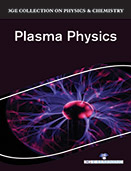Physics

Plasma physics deals with the study of charged particles and fluids relating with self-consistent electric and magnetic fields. It is, generally, a basic research subject having application in the fields of space and astrophysics, accelerator physics, controlled fusion, and beam storage. Over the years, it has been an instant growth in the use of plasmas for different applications. Some factors that have given impetus to, the demands on the excellence and properties of materials, and the surging need for materials with new properties, the initiation of plasmas and plasma-based technologies into production. Nowadays, one has a whole range of industrial applications where the utilization of plasmas-based technologies provides different advantages over other more conventional technologies. Some of these uses may include etching and deposition (in semiconductor wafer processing), deposition and polymerization (in manufacture of optical fibers, treatment of fibrous materials, etc., surface change by removal of diamond films, corrosion resistance coatings, etc., plasma immersed ion implantation for plasma nitriding, etc., for ceramic coating and plasma pyrolysis applications in flat plate displays, and high-pressure jets.
“Plasma Physics” leads to a rich array of properties of the plasma state. This book contains discussion of some fundamental plasma phenomena, introduces key plasma properties like quasineutrality, shielding, particle transport processes and sheath formation, as well as elaborates the simplest plasma models. The basic physical mechanisms behind different plasma discharges have been unveiled. If the charge density in a quasineutral plasma is perturbed, this induces a change in the electric field and in the polarization of the plasma. The small but finite inertia of the charged particles in the plasma cause it to respond collectively with Debye shielding, and oscillations or waves. When the characteristic frequency of the perturbation is low enough, both the electrons and the ions can move rapidly compared to the perturbation and their responses are adiabatic. Then, we obtain the Debye shielding effect discussed in the preceding paragraphs.
The fundamental collective processes in plasma - Debye shielding, plasma sheath, plasma oscillations, and ion acoustic waves – have been explored. Discussions of applications of these fundamental concepts to various basic plasma phenomena are interspersed throughout the book. Serves as valuable guide for graduate students and advanced undergraduates, this text emphasizes the fundamental principles that apply across many different contexts.